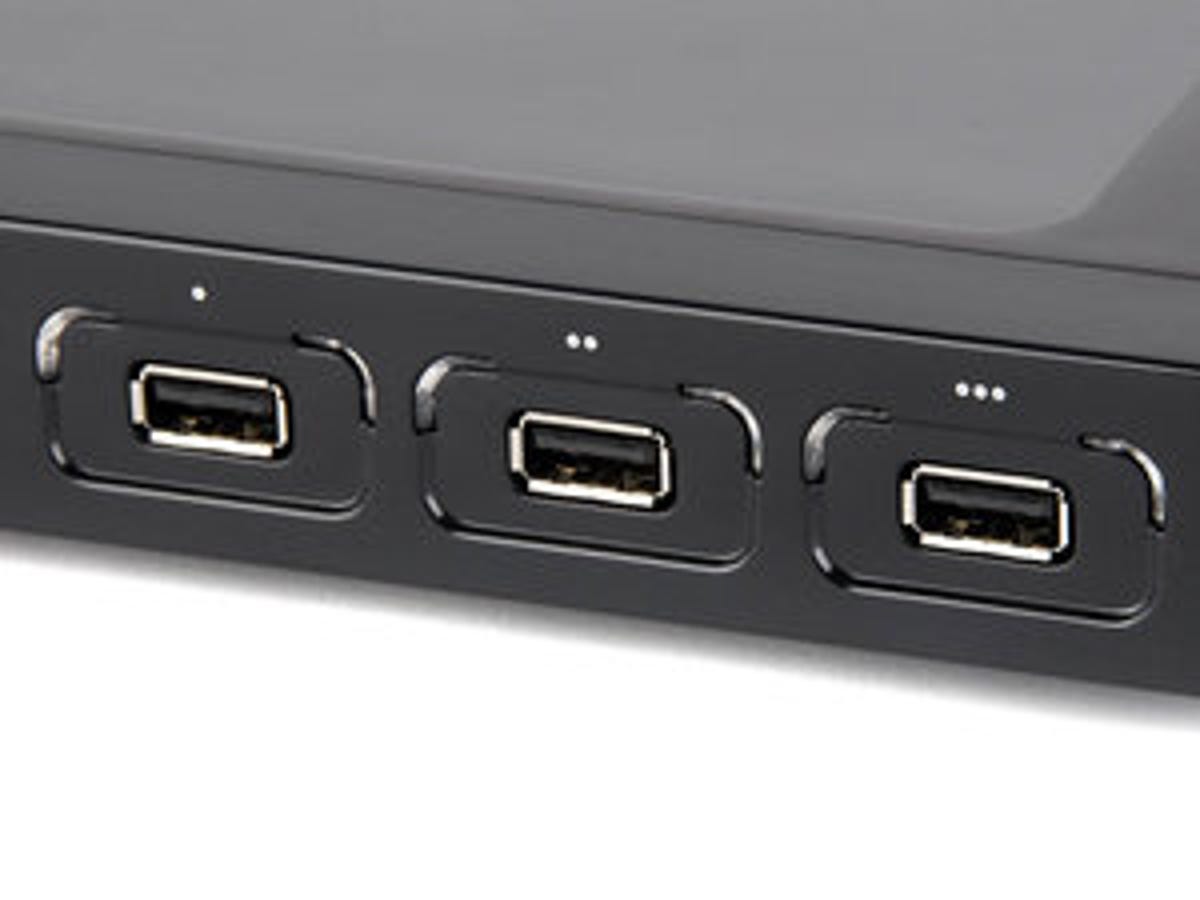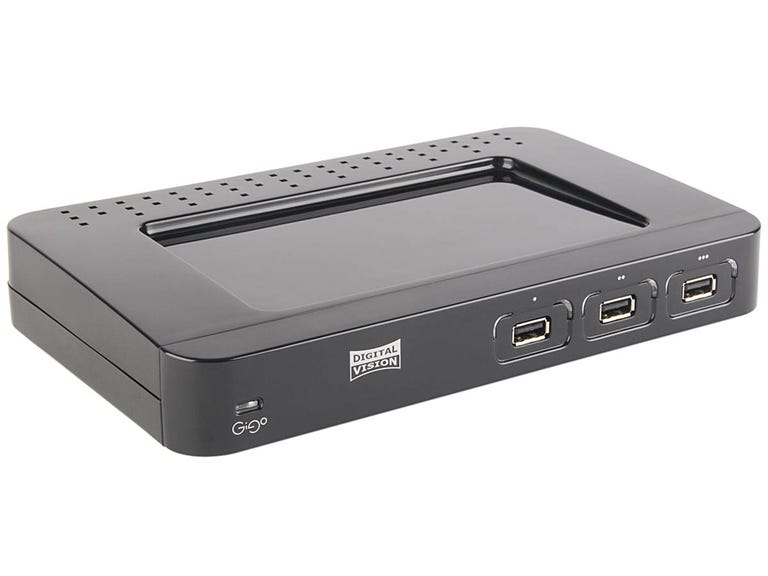 Why You Can Trust CNET
Why You Can Trust CNET Digital Vision GiGo review: Digital Vision GiGo
The GiGo Freeview personal video recorder doesn't have the best build quality you'll ever encounter and it's a fairly ugly piece of kit. But it does what it does -- recording programmes to USB storage -- very well, and will appeal to those who want to take their TV out and about
With Freeview recorders starting at around £20 these days, it's pretty important for any manufacturer charging more than that to have a compelling reason for doing so. Digital Vision thinks it does with the £70 GiGo, designed not only to receive Freeview but also to record it.
The Good
The Bad
The Bottom Line
The GiGo isn't all it seems, because it records TV programmes not to a hard drive but to one of three USB memory cards which the owner provides. Using these memory cards means that you can record TV and take the files with you for use on a laptop or portable media player.
Construction
The build quality of the GiGo is pretty horrendous. It's made out of basic plastic that feels cheap to the touch. To save money, Digital Vision has avoided implementing every possible luxury. It's taken this to such an extreme that the two halves of the case are held together by just one screw. This means that, if you grab the edges, you can easily prise them apart.

But, in this case, we don't think the build quality really matters. It's a shame that the company doesn't ship its hardware in a nifty aluminium case, but the fact is that the quality of the build is unlikely to be an issue for most people, as they'll lob the GiGo under their TV and forget about it.
Freeview recording
The GiGo works by recording exactly what's sent through the air to your TV antenna. If you tell the box that you want to record BBC One at 9pm for one hour, it saves all of the transmitted information to the memory card. This means that, if you take the memory card to a PC or other device that can play MPEG-2 files, you'll get the best possible quality.
The GiGo also has a full Freeview electronic programme guide. We've used plenty of these in the past, and the one in this machine really impressed us. It's graphically simple, but not too ugly, and it responds quickly to remote key presses. All in all, it provides a very pleasant user experience.
Because the GiGo can record to three separate USB drives, you're given the opportunity to select which drive to record to when you schedule a recording. Although we like this feature, it's potentially quite confusing -- you'll have to remember which drive is going to record which programme. If you want to remove one of the USB sticks, you'll have to be sure that you haven't scheduled a recording on it. A status light tells you when the USB memory stick is inserted and another light tells you when it's being recorded to.
The only slight oversight is that the GiGo has just a single Freeview tuner. This means watching one channel while recording another is impossible, as is recording two channels at the same time. We were, however, very impressed to see that the GiGo is capable of recording subtitles into the MPEG video stream. That's great news if you have a hearing problem, or just want to see what the chavs are actually saying during the shouting matches on The Jeremy Kyle Show.
Picture quality
Hooked up via Scart to a high-end LG plasma TV, the GiGo did a passable job of presenting a high-quality TV picture. As with the unit itself, every possible penny has been pinched during the production of the Scart lead in the box. It is, as such, a piece of junk. We'd suggest throwing it out of a window, or using it as something to entertain your pet snake.
With a more capable Scart lead connected, the GiGo gave a significantly improved picture, without the image distortion that we saw previously. We think the machine should have either a component or HDMI output to obtain the best quality, but that's a plea that's likely to go unanswered.
Even without a high-quality cable, we still noticed a distinct patterning to the picture that was mildly distracting when we sat close to the TV. We were also unimpressed by the quality of the Scart sockets on the machine, which seemed somewhat reluctant to accept any Scart lead at all.
The main blessing of the GiGo, however, is that you don't actually have to watch your recordings back on it. For example, you could plonk the USB card in a media streamer and use that to watch your recordings. The quality will be much better, and there'll be no more worrying about Scart connectors. A Western Digital WD TV or Popcorn Hour A-110 would make short work of these MPEG-2 files, so there are plenty of options for playback.
One glitch
During our testing we discovered one slight problem. We recorded an episode of Desperate Housewives onto a memory stick and attempted to play it back with the VLC 1.0 media player on a Windows XP machine. VLC couldn't play the file, however, despite having no problems with other GiGo recordings. We also tested the file with Windows Media Player and PowerDVD, both of which were able to play it. We've spoken to Digital Vision about this, and its engineers are looking into the problem. It's almost certainly not a hardware problem, and more likely to be an issue with the Channel 4 transport stream.
Ideal for the train
Commuting is utterly soul-destroying, as anyone who has ever tried it will attest. Morning after godforsaken morning, you cram yourself into stinking metal tubes that rumble ponderously over strips of ancient metal. You can reduce the tedium, however, by playing recordings made via your GiGo on your laptop or other portable device. But, because the MPEG-2 files that the GiGo spits out aren't directly compatible with all portable media players, we'd urge you to check that yours can play them before you invest.
If your PMP can play MPEG-2 files, or you're a computer user with apps like PowerDVD or VLC, you should have no problem watching back recordings. What better way to pass the time on a slow journey to work than with yesterday's instalment of The Jeremy Kyle Show?
Who's the GiGo aimed at?
There are two distinct areas in which the GiGo excels. The first is as a simple Freeview set-top box for any old analogue TV. The Scart sockets mean that hooking it up to an older TV won't be a problem. If you've got an old TV and want to get it ready for digital, there's nothing wrong with the GiGo. Its sturdy EPG and chunky remote are likely to make it popular with people who want a reliable box without any fuss.
The second group of people likely to be interested in this box are more technology-focused users who want a way to record Freeview straight to a memory card and then to a hard disk. Simply put: despite its cheap construction and fairly ugly design, this little machine has plenty to offer people with home media centres. The recorded streams are compatible with a host of computer applications, which means integration with something like Windows Media Centre shouldn't be a problem.
Conclusion
If you like hardware that looks and feels like a million dollars, the Digital Vision GiGo really isn't for you. If you're looking for a Freeview PVR that records to USB memory cards and does a jolly good job, we think you'll be pretty pleased with it.
Please note that, at the time we published this review, the GiGo wasn't Freeview+ certified or capable of the functions that come with that service. We've been told by Digital Vision, however, that a firmware upgrade will make that functionality possible in the near future.
Edited by Charles Kloet
